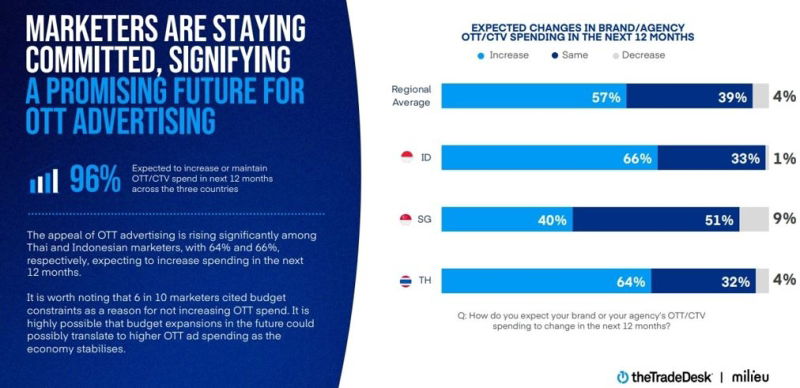
What would a better future in the OTT space look like?
share on
OTT is one of the fastest-growing platforms today, with over 200 million viewers in Southeast Asia alone, attracting more marketers to invest in the platform. In fact, currently, seven in 10 marketers expressed the importance of having OTT as part of their marketing strategy with nearly a third stating that it was very important. These were the results of The Trade Desk's The Future of TV is with OTT report, which was worked on in tandem with Millieu Insight to find out from senior marketers in the region what their adoption of OTT looked like.
Don't miss: LinkedIn is going into CTV. Here's why
However, despite being a new exciting way to reach users, OTT isn't without its challenges, said industry professionals speaking at a panel at The Trade Desk's The Future of TV event.
One of the core issues, according to Abhishek Grover, chief digital officer (consumer products) at L’Oreal, is that all marketers are fighting for almost the same subscribers and users. Moreover, there is still a fair bit of fragmentation in the OTT space with many different platforms offering a myriad of solutions, without a consolidated way of measurement. For example, there is a wide range of ad formats available such as advertising-based video on demand, broadcaster video on demand and more.
"There are so many players within the OTT space, and an issue we as marketers face is, how do we know that we are investing in the right channels," asked Grover.
"At L'Oreal, we believe that our campaigns can be successful only if we have fewer, bigger, better campaigns," he added. "We don't want to just invest across different channels, but really, we want to understand the role of the platform and the objective of advertising on it," he said.
Grover went on to explain that in his opinion, the future of OTT is likely to have more advanced capabilities of measurement, as the industry consolidates. This will then aid with tracking, as well which will help brands to understand the impact they are driving.
Grover was also of the view that beyond measurement metrics, such as reach and frequency metrics, marketers also want data to understand consumer interest trends. With consolidation of the industry, marketers might be empowered with richer data signals on trends, enabling them to know what content marketers should put their money behind.
"It will help us create content that is not just pushed out but something the consumer genuinely wants to watch," he said. "It's all about trends. If you capture the trend at the right moment and you are able to create engaging content on the trend, you will have viewers."
Agreeing with him, Helen McRae the APAC CEO of Mindshare said that with this consolidation, she believed that there was also going to be more research into helping marketers figure out the right value exchange with people choosing to pay for good content or opting out and saying that they don't want to pay.
"The challenge then is for advertisers and agencies to step up and say what does that good content look like and how can we integrate it with the content," she said.
McRae added that what makes the space even more complicated is the fact that many clients are now facing challenges in overall digital transformation, and the ability to get a single view of the consumer. As such the questions being asked are often around creating relevance, connection and retention with the consumers – and wondering if OTT provides that opportunity.
“As agency partners we have to solve or help solve some of those problems as they go on their digital transformation journey,” she added. McRae explained that the future of OTT is going to be more about integration and not interruption. "I don't think we're quite there yet with that and personalisation, but I think AI is going to sort all that out for us," she said.
Is there a better future?
One of the main reason OTT has worked well in attracting marketers is because of its effective reach and the polished look and feel of the content. OTT also impacts three key stages of the marketing funnel which is driving brand awareness, followed by brand consideration and driving purchase intent.

Currently OTYT platforms have 12% more brand awareness and 10% more product recalls. When it comes to consideration there is a 35% increase in trust for a brand advertising on OTT/CTV. Last but not least, consumers are 35% more likely to purchase a product they see advertised on OTT/CTV, said the Future of TV report by The Trade Desk.
When it comes to geographical statistics, the appeal of OTT advertising is particularly growing for Thai and Indonesian marketers, with 64% and 66%, respectively. Nonetheless, a large majority still face budget constraints at the current juncture.

The biggest conference is back! Experience the future of marketing with 500+ brilliant minds at Digital Marketing Asia on 28 - 30 November in Singapore. Uncover groundbreaking strategies that connect leading brands with their target audiences effectively.
Related articles:
Why brands need to tune into OTT
What you need to know before spending on OTT
Young Millennials, Gen Zs and females in SEA more willing to watch ads for free OTT content
share on
Free newsletter
Get the daily lowdown on Asia's top marketing stories.
We break down the big and messy topics of the day so you're updated on the most important developments in Asia's marketing development – for free.
subscribe now open in new window
